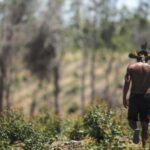This article is the first of 5 articles in the ‘Building a winning forest impact investment strategy’ series.
Join The ForestLink’s newsletter so that you don’t miss an article, and register your interest for the exclusive ForestLink Impact Investment Seminar coming up this autumn.

Defining impact investment
Impact investing is an investment approach with many definitions and is used across a spectrum of investor types with varying return/impact expectations. To remain credible, and realize meaningful impact and financial returns, I support the GIIN definition, which states that: “impact investments are investments made with the intention to generate positive, measurable social and environmental impact alongside a financial return”. To differentiate impact investing from other responsible investment nomenclature, below are my descriptions of sustainable investing and ESG investing, and why I see these as different from impact investment.
Sustainable investing
Sustainable investing refers to investments that maintain social, environmental, and economic conditions, to serve present as well as future needs. Compared to impact, sustainable investments do not necessarily require impact to be generated. Instead, they require no harm to the social, environmental, and economic condition, so that future needs can be met. Therefore, the element of additionality (producing beneficial social or environmental outcomes) that is present in the impact investment approach, is lacking.
ESG investing
ESG investing, or investments heeding to environmental, social and governance factors, look to understand the material impact of ESG on the performance of an investment. These factors are integrated into traditional financial analysis to understand what risks, or opportunities, may arise financially from the ESG characteristics associated with a particular investment. Compared to impact, ESG investing does not look to generate impact through its consideration of ESG factors, it looks to maximize financial return, through interventions to reduce ESG risk, and leverage upon opportunities.
How to avoid greenwashing accusations through choosing an impact investment strategy
As sustainable investing and ESG investing are both responsible investment approaches, why would an investor choose an impact investment approach? Naysayers may argue that impact investment entails more work to identify impact themes and proactively manage for, and measure impact results, in addition to maintaining sustainability and ESG principles.
As the pressure to clean up investors’ balance sheets rises, so has greenwashing. Investors are coming up with interesting ways of packaging conventional investments to make them appear ‘climate positive’ or by providing downright false claims on an investment’s “green” benefits. The Financial Times recently published an article, “Greenwashing in Finance: Europe’s push to police ESG investing” that highlights this problem. In answer to it, financial regulators in Europe are actually changing reporting requirements to make ESG investing more like impact investing (at least in the reporting, which implies some degree of management).
As impact investment requires the intention to create positive impact, as well as the management and measurement of it, true impact investments will not fall prey to greenwashing as investors will be able to demonstrate climate benefits.
Pursuing forest impact investments in tropical settings
If you are considering a forest investment in a tropical setting, I would argue that an impact investment approach is almost a necessity.
The following characteristics of a forest impact investment approach in the tropics highlight the potential to contribute to climate resilience and sustainable development, whilst generating attractive market-rate returns in emerging markets.
- Environmental impact: Restore degraded land, protect vulnerable forest ecosystems, foster climate positive growth and development,
- Social impact: Provide high-quality rural jobs, foster a culture around health and safety, provide training and education, realize climate change adaptation through providing alternative livelihoods and creating climate resilient landscapes (food production, wood production, soil and water quality, and biodiversity),
- Financial returns: Realize early mover advantage into growing markets.
Furthermore, I would argue that investors wanting to employ a sustainable investment or ESG investment approach have limited opportunity to invest in the tropics, because risks would be seen as too high.
With an impact investment, these risks can be reframed as opportunities. Risks such as encroachment into commercial forest area could be turned into an opportunity, where encroaching farmers can be trained in climate-smart agriculture techniques. This would have the impact results of climate resilience, food security and improved livelihoods, and the financial return benefits of securing the biological assets of the planted production forests.
Considerations for a winning forest impact investment strategy in the tropics
The following table provides a snapshot of the components that need to be considered when designing an impact investment strategy in the tropics.
By considering these elements, and understanding if your objectives are compatible with each other, you will be in a strong position to source the appropriate deals and in turn design a winning portfolio.
Impact strategy elements
Investment type
Considerations for forest investment in the tropics
The most common ways to invest into forests is through debt or equity. Which is your preferred way to invest? I would argue that earlier stage forest investments that are not yet cashflow positive, or that will not be cashflow positive within your investment horizon are not suitable to debt.
Target financial returns
Are you seeking market rate returns, looking for a return of capital, or are you investing on a concessional basis, where your impact objectives outweigh your financial objectives?
Impact thesis
What impacts are important to you? Consider the following relationships and alignment with the UN’s SDGs (Sustainable Development Goals):
SDG 13 – Climate Action & SDG 15 – Life on land
- Carbon sequestration via development of productive forests and forest restoration
- Carbon storage via forest conservation and biodiversity enhancement
SDG 8 – Decent work and economic growth
- Job provision and decent pay
- Workplace training and health and safety
SDG 12 – Responsible consumption and production
- Provision of sustainably produced renewable wood products
- Efficient processing of wood produc
Target markets
Are you looking for existing markets, such as structural timber or manufactured wood products, and renewable biomass? Or, are you interested in the burgeoning markets of carbon, biodiversity and other ecosystem services?
Forest value chain exposure
Where do you see your investments within the various stages of the forest value chain?
- Enabling environment support: Land permits, species selection and sourcing, stakeholder consultation, feasibility studies, infrastructure development
- Early growth: Infrastructure development, first years of planting
- Late growth: Continued planting, early harvests and early processing
- Industrialization: Final harvests and industrialization of processing
- Ecosystem services
Time horizon
How long do you want to hold your investment? Short-term (1-4 years), medium term (5-10 years), or long-term (+10 years)
Liquidity
Do you require cashflow immediately, in the near or long-term?
The above table represents a variety of strategy considerations but is in no way exhaustive. For example, it doesn’t consider risk appetite, geographical preference, diversification requirements, and others.
Testing your objectives’ compatibility
Let’s use an example of particular objectives you might have to test their compatibility. Assume you are looking to build a forest impact portfolio of equity investments, where you are seeking market rate returns.
With respect to impact, you want to:
- emphasize the climate benefits of carbon sequestration and storage
You are interested in:
- Accessing structural timber and carbon markets,
- The potential for other payments for ecosystem services,
- Late growth and industrialization,
- A short-term investment that is already cashflow positive.
Is all this possible within the same strategy? For the most part, I would say yes. If you are seeking market rate returns over a short time horizon, you are going to want to invest into projects that are mature or nearing maturity, where timber markets are already well developed.
From an impact perspective, carbon sequestration is highest in the late growth stage of the forest value chain (consistent with your objectives) but proving additionality and accessing carbon markets could be more challenging (as you are essentially purchasing existing forest). However, perhaps with your investment into an existing production forest, you can improve the forest management. Over your holding period, you replace the current monoculture with more of a mosaic forest (native and commercial species mixed across the landscape) and increase the amount of forest that will be set aside and even restored for conservation values.
In this case, it would be possible to reach both your financial and impact objectives (with the caveat that the climate benefits may be limited in the short time horizon).
The importance of considering the whole investment cycle
As you go through the process of designing your architectural blueprint for your forest impact investment strategy in the tropics, the types of deals to source will become clear, and the whole investment process will become more straightforward. You can design specific screening criteria, a more in-depth due diligence framework, and build the right team of experts to support you with deal assessment and transactions, and with investment and operational management.
Having clarity in your strategy will also assist you in developing an exit plan early on. This is important not only for achieving your financial objectives, but also for your impact objectives – as these are often only fully realized after you have exited an investment. If focusing only on financial returns at exit, the next phase investor might not continue with your impact trajectory and all the great impact you initiated could be lost.
So, for a winning forest impact investment strategy in the tropics, full cycle thinking is critical to achieving both your financial and impact objectives.
Accelerate your learning and save time
The process of developing an impact investment strategy for forests in the tropics is a complicated task even for the savviest of timberland investors and advisors.
I will continue this 5-part series on “Building a winning forest impact investment strategy”, with an emphasis on tropical settings over the coming weeks. Sign up now for my newsletter and don’t miss an article, so that you can gain insights, accelerate your learning, and save time in your strategy development journey. When you sign up to my newsletter, you can also register your interest for the exclusive ForestLink Impact Investment Seminar coming up this autumn (more details to follow soon).
If you are looking for more customized support with the development of your forest impact investment strategy in the tropics, please reach out.





